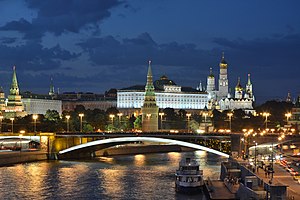Moscow Kremlin
| Moscow Kremlin | |
|---|---|
|
Native name Russian: Моско́вский Кремль |
|

View of the Kremlin from the Moscow River
|
|
| Location | Moscow, Russia |
| Coordinates | 55°45′6″N 37°37′4″E / 55.75167°N 37.61778°ECoordinates: 55°45′6″N 37°37′4″E / 55.75167°N 37.61778°E |
| Area | 27.7 hectares (0.277 km2) |
| Built | 1482–1495 |
| Official name: Kremlin and Red Square, Moscow | |
| Type | Cultural |
| Criteria | i, ii, iv, vi |
| Designated | 1990 (14th session) |
| Reference no. | 545 |
| State Party | Russia |
| Region | Eastern Europe |
The Moscow Kremlin (Russian: Моско́вский Кремль, tr. Moskovskiy Kreml; IPA: [mɐˈskofskʲɪj krʲɛmlʲ]), usually referred to as the Kremlin, is a fortified complex at the heart of Moscow, overlooking the Moskva River to the south, Saint Basil's Cathedral and Red Square to the east, and the Alexander Garden to the west. It is the best known of the kremlins (Russian citadels) and includes five palaces, four cathedrals, and the enclosing Kremlin Wall with Kremlin towers. Also within this complex is the Grand Kremlin Palace. The complex serves as the official residence of the President of the Russian Federation.
The name Kremlin means "fortress inside a city", and is often also used as a metonym to refer to the government of the Russian Federation in a similar sense to how the White House is used to refer to the Executive Office of the President of the United States. It had previously been used to refer to the government of the Soviet Union (1922–1991) and its highest members (such as general secretaries, premiers, presidents, ministers, and commissars). "Kremlinology" refers to the study of Soviet and Russian politics.
...
Wikipedia

